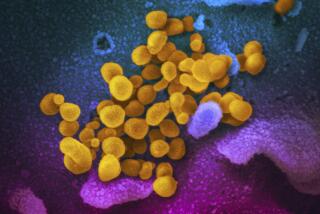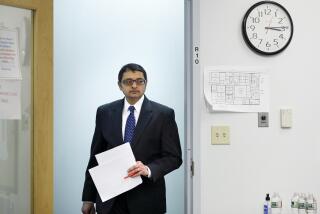Clinton Plans Funds Hike to Fight Cancer
WASHINGTON â President Clinton today will propose a funding increase for research into potentially cancer-causing environmental toxins that would allow federal scientists to quadruple the number of dangerous toxins they study.
The money, which would flow to the Environmental Health Laboratory at the federal Centers for Disease Control and Prevention, would permit the lab to increase from 25 to 100 the number of potentially toxic substances it monitors.
It also would allow the lab to use new and more precise technology to help state and local public health officials investigate increased incidence of cancer or other diseases potentially linked to environmental substances.
âThere is hardly a state in the country that doesnât get confronted on a daily basis with questions about environmental health issues--lead, asbestos in buildings, pesticides, fertilizers in water,â said Dr. Jeffrey P. Koplan, director of the CDC.
âThe new funds will allow us to markedly increase the range of chemicals we can test for and we can refine the tests we have so that they are faster, more accurate and cheaper so that they can be used more easily by our partners in the states.â
If approved by Congress, the funding increase would bring the agencyâs budget in fiscal 2001 to $27 million--a 56% increase over this yearâs level.
Such environmental factors as cigarette smoking, diet and exposure to certain chemicals, including asbestos and benzene, may account for as many as three-quarters of all cancers, according to the American Cancer Society. Other chemicals are thought to heighten the risk of cancer, although no direct link has been established.
In recent years, there has been a growing clamor to investigate unusual geographic clusters of cancers, birth defects and other disorders for their possible links to common environmental exposures, coupled with increasing scientific evidence that such toxins could play a role in their development.
Until recently, the only way researchers could track environmental links to cancer was to wait years until groups of people developed a disease. Then scientists would try to determine which dangerous substances people might have encountered.
In Long Island, N.Y., for instance, where a disproportionate number of women develop breast cancer, researchers have interviewed hundreds of people in an effort to figure out what kinds of environmental hazards might have existed before complete records were kept.
Technological advances have enabled scientists to measure the level of toxic substances at the molecular level in blood, tissue and urine so that people can be tested much earlier--before they develop the diseases--to determine levels of exposure and potential toxicity.
âThe lab is a unique testing facility which permits us to test for infinitesimal amounts of chemicals and toxins in the human body, and there are barely any other places in the world that can test for a spectrum of chemicals,â said Koplan.
For example, if local health officials received complaints about an increase in the number of people with a specific kind of cancer, they probably would do their own investigation and narrow the potentially toxic culprits to a short list. Then the lab would provide the technology and support to help local officials test for levels of the chemical, for instance, in blood or urine and analyze the results.
âThis will address the publicâs concern about the possible relationship between environmental pollutants and cancer risks and provide information we donât have yet,â said Joann Schellenbach, spokeswoman for the American Cancer Society.
A further puzzle is why some people in a cluster develop cancer while others living in the same area do not. The labâs scientists hope eventually to be able to mesh the information they collect with genetic data to more precisely determine why such situations occur.
This type of research will not replace the large epidemiological studies of humans, but taken together the two methods could speed up researchersâ understanding of the relationship of environmental toxins to human cancers.






